We walked across the bridge to come and go from the van. We stayed in #6 and we got to the park by walking up the hill just to the west of the lodge.
First view and first photo. It took a while to figure out how best to take photos. We often would switch to manual focus (automatic focus would mostly focus on branches and leaves between us and the orangutan) and then we had to experiment with lighting.
In Malay/Indonesian orang means person and (h)utan means jungle. So orangutan means person of the jungle. I hunted for videos showing the correct pronunciation (as in how do Indonesians pronounce it) and all but one got it wrong. This is the best example I could find:
https://www.youtube.com/watch?v=pfjFvaX5dAo Vowles in Indonesian are like Spanish vowel pronunciations. Orang is not pronounced with a long A as in bang, but with a short A as in long. Also there is not final G so do not say utang as in Tang the orange drink.
These first few sightings were all in a transition zone between town and agriculture and the national park. At one point this area was a rehabilitation facility where captive, abandoned or hurt orangutans were brought to re-introduce them back into the wild. Many of the orangutans were saw were semi-wild and had had long exposure to humans. They were unphased by us humans gawking at them.
Orangutans are also susceptible to COVID: stay 10 meters apart, don't feed them, don't pee in the jungle.
This youngster loved rolling in the leaves while the mother looked on.
Huge inch long ants were everywhere. They did not bite even when some in our group let them crawl on their hands.
I think we were all most excited and most honored to have been able to watch this big old guy.
A smaller orangutan watching all of us fawning over the big guy.
I-phone cameras did not do very well in the mixed lighting and mixed focal points of the jungle so Will and I shared my Canon camera. Many of these photos were his, while I looked on. Both of us loved watching through a lens waiting for the perfect shot.
When the big guy hit the ground, our guides kept us at safe distance. I took this photo of Luke watching and waiting while I did the same thing from behind a big log.
Pretty sure this guy was also rehabilitated, given that he came down to our level instead of staying safe up in the trees.
This photo does not illustrate the heat, humidity and sweat we were all experiencing.
We stopped for lunch and the students got a short lecture about dipterocarps--the main specie of trees in Indonesia's tropical forests, oxisols--the infertile soil of the tropics, and how these trees growing in this soil all have lateral roots to soak up the water and decomposing organic materials on the surface above the poor soil below.
Picnic lunch of nasi goreng (fried rice and fixings) wrapped in a banana leaf and paper.
Because they do not need deep roots to find water or nutrients, most tropical tree have stabilizing roots and fins like this to help keep them standing..
The trek after lunch took us down and up through some thicker forest. It was hard and hot going. We were then given an option. Take a shorter root to our river side camp going down a hill and along the river or continue on the originally planned long route, up and down four more hills and then down a final steep descent to the camp. This route promised more opportunities to see wildlife. Four of us--65 year old me, 17 year old Will plus Luke and McKay (and our two great guides) opted for the longer (3-4 more hours) route which only took us about 2 hours.
When we got to the top of the first hill, we stopped to rest where two other people and their guide had also stopped.
There we saw our final orangutan of the day, just causally climbing through the canopy up to our hill top.
While we were watching the orangutan we heard a ruckus to our right. Soon a group (gaggle?) of gibbons came swinging Tarzan style through the trees right at our eye level, but far up in the trees rising from down the steep slope.
It was next to impossible to get any good photos of this parade due to their speed and forest darkness.
But I did get one good shot.
Gibbons gone, it was back to watching this guy adroitly move from tree to tree.
I was in orangutan heaven. Ever since my mission I have been enchanted with this unique species. I have also been traumatized by how endangered they are. This was worth an 18 hour bus ride and a hot hike.
It then dropped down to the ground--perhaps drawn in by an orange peel (not ours).
My hiking poles helped a lot along the steep slippery trail. but in same places using hand holds of nearby roots and vines worked the best.
Fresh cut fruit snack in the middle of the jungle.
Three hills down and one to go.
Luke using a batik fan to help cool down.
When we all assembled earlier in the morning, some of the students came out in Tevas and shorts thinking we were going on a stroll through the botanical garden of Bogor. When I reminded them that we would be trekking through a jungle with leaches, ants and mosquitoes several students went back and put on long pants and socks. They were glad they did, Several of us had leech encounters during the two days.
The long final descent from the last hill top down to the river camp was rough. It was about a70 degree slope. Roots and vines became my best friend.
Thank to agile Will for keeping an eye on his "old man".
The cool river was such a delight. I kept submerging myself to cool my body down.
We arrived just after the majority of the short-trail group. Apparently they also had a few steep slopes with thick vegetation. Most problematic was that the larger group had a wider range of speeds (our group of four kept together the whole way). There was one group who moved quite fast and got ahead of the lead guide who was hanging back to check on others. At some point three groups emerged within the larger group and somehow the last group of two got behind the tail-end guide and were left behind. They tried to find their way, but really had no clue which way to go after reaching the river so after trying a few options, they eventually headed back to the place where the trail first met the river and they waited--even making plans about how to ration their oreo cookies until found. Several guides hustled out to retrieve them and eventually found them patiently and hopefully waiting.

Here they are arriving opposite our camp. Dan Olsen, also had part of the trail collapse under him dropping him about 10 feet down the slope so he was stiff for a few days.
It was a relief to finally all be back together.
That evening we all enjoyed a diner of rice and curries, before sleeping within mosquito protective nets on thicker-than-our-Tambora mats under a wood and plastic shelter that efficiently kept us dry during the nighttime cloud burst.
The next morning was beautiful as the light emerged.
I watched a family of monkeys on the opposite bank.
Such a pretty color of river.
Almost brought this mica flecked stone home to join my travel rock collection. Took a photo instead.
A family of monkeys on our side of the river.
Cover you eyes!
Our camp. There were several other groups in similar camps scattered along this part of the river.
After a triple layer breakfast sandwich, we walked up stream and then across the river and up a side stream to a water fall and pool (no photos). I took my first and only tumble on the slippery moss covered rocks near the pool and also ended up with a few sore spots.
Then we headed down river on rafts of inner tubes lashed together and backpacks wrapped well in plastic bags.
A hour later we were back in Bukit Lawang and a five minute walk from our lodge. (four previous photos courtesy of Dallin Hutchinson)
We arrived at the lodge mid afternoon. Danny, who had arrived at the lodge with severe intestinal disorders had stayed at the Eco lodge with a stash of Pocari Sweat, water, crackers and under the care of one of the guides and a visit from the tour company doctor. He was also in phone contact with his mother, a nurse. I had promised him that if he was feeling better we would see about a late afternoon visit into the national park. He was weak, but wanted to go. I invited any others in our group to join us. Will and McKay decides to come along.
We got lucky. Impeding rain did not fall and just where the last tourist lodge met the forest we were able to sit on the lawn of the lodge and watch for about an hour as a mother and child orangutan moved through the trees and down to the ground.
This cute guy was there the whole time too. (sorry I don't know specific species names of the non- orangutans)
The orangutan child looked like he wanted to play with the monkey.
She came down to grab a coconut cup filled with solidifying rubber sap.
Favorite photo of the two days.
Looking west to where we trekked the previous day.
A second course of rubber.
















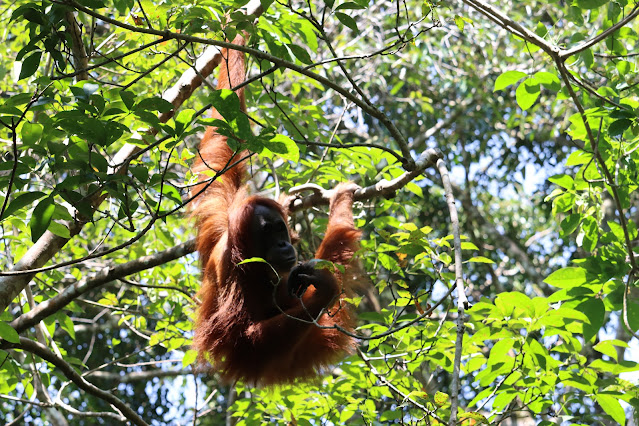





























































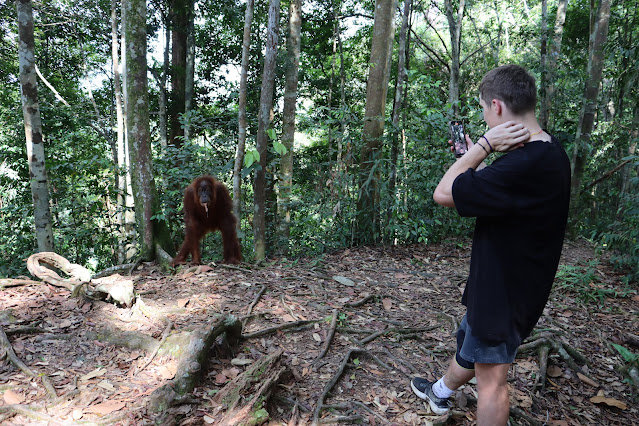

































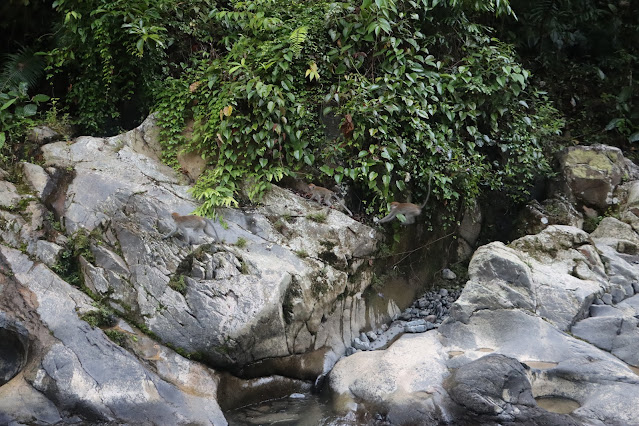







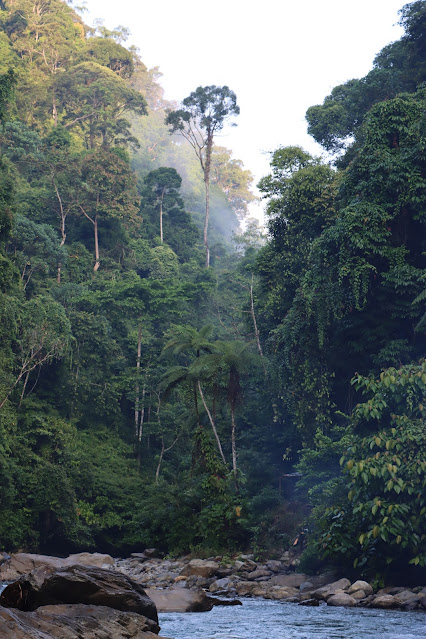






























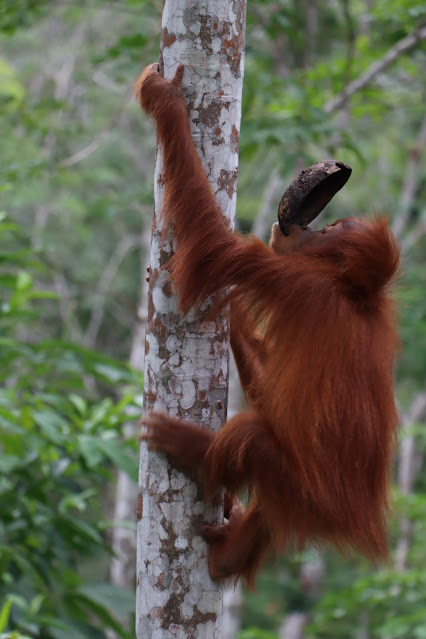



















No comments:
Post a Comment